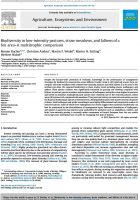Biodiversity in low-intensity pastures, straw meadows, and fallows of a fen area – A multitrophic comparison
Bucher R., Andres C., Wedel M.F., Entling M.H., Nickel H. 2016. Agriculture, Ecosystems and Environment

Abstract
Despite the Europe-wide protection of wetlands, knowledge on the performance of management strategies for biodiversity conservation across different trophic levels is still relatively scarce. Here, we compare old straw meadows with restored low-intensity pastures and with fallows in a fen area in the northern pre-Alps. We sampled biodiversity at three trophic levels including plants, leafhoppers and spiders. Plant species richness was significantly enhanced by grazing and mowing compared with fallows. In contrast, species numbers and abundances of leafhoppers and spiders were highest in pastures and lowest in meadows. Endangered plant species were relatively rare in the restored pastures, which were still nutrient rich compared with meadows. Thus, land-use history can constrain restoration success for dispersal limited plant species in the short term. Although fallow plots were poorer in terms of species richness, their leafhopper and spider assemblages were highly differentiated and comprised a number of exclusive species, some of which were endangered. Our results suggest that maximum biodiversity can best be maintained by the diversification of management types. Enhanced abundances of leafhoppers and spiders in pastures may improve prey availability for predators such as amphibians, reptiles, and birds. Low-intensity grazing is currently rather uncommon in Central European fens, but our results encourage more widespread use of cattle for managing this type of habitat.
Download
Biodiversity in low-intensity pastures, straw meadows, and fallows of a fen area


